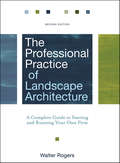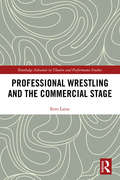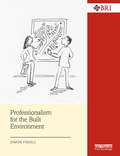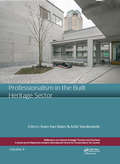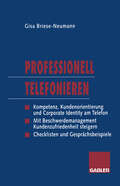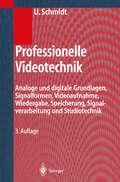- Table View
- List View
The Professional Practice of Architectural Working Drawings
by Nagy R. Bakhoum Osamu A. WakitaUnique resource combining guidance on professional practice with creating working drawings that clearly communicate a design between builder and client Revised and updated with new content reflecting the urgent challenges of sustainability and working life, The Professional Practice of Architectural Working Drawings is a complete guide to the skills needed to create a set of drawings that clearly and effectively communicate a design, combining the practice of architecture with the development of working drawings—two concepts which are inherently intertwined. This Sixth Edition has been extensively edited, tightened, and rearranged, with a fresh approach matching the experience of students moving into their first professional positions. With new examples and images throughout, The Professional Practice of Architectural Working Drawings contains information on: Processes and procedures of developing working drawings, to organize and educate students in this important skill Crucial concepts that real-world techniques architects rely on every day, from site, floor, framing, and foundation plans, to building sections and elevations Standards, customs, regulations, and symbols, alongside computer-generated drawings, 3D modeling, Building Information Modeling, and other architectural technology Sustainable concepts, foundation types, building sections, schedules, and more The Professional Practice of Architectural Working Drawings is an ideal learning resource for beginner, intermediate, and advanced drafting courses, ranging from high school to community college and into the first and second years of traditional university courses. The text may also be helpful for professionals looking to advance their skill sets.
The Professional Practice of Architectural Working Drawings
by Nagy R. Bakhoum Osamu A. WakitaUnique resource combining guidance on professional practice with creating working drawings that clearly communicate a design between builder and client Revised and updated with new content reflecting the urgent challenges of sustainability and working life, The Professional Practice of Architectural Working Drawings is a complete guide to the skills needed to create a set of drawings that clearly and effectively communicate a design, combining the practice of architecture with the development of working drawings—two concepts which are inherently intertwined. This Sixth Edition has been extensively edited, tightened, and rearranged, with a fresh approach matching the experience of students moving into their first professional positions. With new examples and images throughout, The Professional Practice of Architectural Working Drawings contains information on: Processes and procedures of developing working drawings, to organize and educate students in this important skill Crucial concepts that real-world techniques architects rely on every day, from site, floor, framing, and foundation plans, to building sections and elevations Standards, customs, regulations, and symbols, alongside computer-generated drawings, 3D modeling, Building Information Modeling, and other architectural technology Sustainable concepts, foundation types, building sections, schedules, and more The Professional Practice of Architectural Working Drawings is an ideal learning resource for beginner, intermediate, and advanced drafting courses, ranging from high school to community college and into the first and second years of traditional university courses. The text may also be helpful for professionals looking to advance their skill sets.
The Professional Practice of Architectural Working Drawings
by Osamu A. Wakita Nagy R. Bakhoum Richard M. LindeThe detailed, highly illustrated, comprehensive guide to architectural working drawings The Professional Practice of Architectural Working Drawings is a complete guide to the skills you need to create a set of drawings that clearly and effectively communicate your design. Covering everything from site, floor, framing, and foundation plans to building sections and elevations, this book presents crucial concepts and real-world techniques architects rely on every day. You'll learn the standards, customs, regulations, and symbols, alongside computer-generated drawings, 3D modeling, Building Information Modeling, and other architectural technology. This new fifth edition includes updated information on sustainability concepts, layering systems in line with AIA standards, deeper explorations of dimensioning, more sample ADA drawings, and a new selection of case studies that offer a real-world glimpse into how these topics relate to the architect's everyday work. Hundreds of drawings demonstrate important skills and concepts, and online ancillary materials offer a robust set of resources to students and instructors. Architectural drawings must be precise, accurate, and complete; they must follow certain standards that make them universally understood in the proper context. This book teaches you how to produce professional-level drawings that leave no room for questions or confusion. Create architectural drawings that effectively communicate your design Learn techniques used in both residential and light commercial projects Investigate BIM, 3D modeling, and other architectural technologies Understand dimensioning, sustainability, ADA standards, and more Architects use drawings as a second language, to effectively communicate ideas to clients, contractors, builders, and other design professionals throughout all stages of the project. The Professional Practice of Architectural Working Drawings teaches you how to become fluent in the visual language of architecture, to communicate more effectively with all project stakeholders.
The Professional Practice of Architectural Working Drawings
by Osamu A. Wakita Nagy R. Bakhoum Richard M. LindeThe detailed, highly illustrated, comprehensive guide to architectural working drawings The Professional Practice of Architectural Working Drawings is a complete guide to the skills you need to create a set of drawings that clearly and effectively communicate your design. Covering everything from site, floor, framing, and foundation plans to building sections and elevations, this book presents crucial concepts and real-world techniques architects rely on every day. You'll learn the standards, customs, regulations, and symbols, alongside computer-generated drawings, 3D modeling, Building Information Modeling, and other architectural technology. This new fifth edition includes updated information on sustainability concepts, layering systems in line with AIA standards, deeper explorations of dimensioning, more sample ADA drawings, and a new selection of case studies that offer a real-world glimpse into how these topics relate to the architect's everyday work. Hundreds of drawings demonstrate important skills and concepts, and online ancillary materials offer a robust set of resources to students and instructors. Architectural drawings must be precise, accurate, and complete; they must follow certain standards that make them universally understood in the proper context. This book teaches you how to produce professional-level drawings that leave no room for questions or confusion. Create architectural drawings that effectively communicate your design Learn techniques used in both residential and light commercial projects Investigate BIM, 3D modeling, and other architectural technologies Understand dimensioning, sustainability, ADA standards, and more Architects use drawings as a second language, to effectively communicate ideas to clients, contractors, builders, and other design professionals throughout all stages of the project. The Professional Practice of Architectural Working Drawings teaches you how to become fluent in the visual language of architecture, to communicate more effectively with all project stakeholders.
The Professional Practice Of Architectural Working Drawings: (pdf)
by Osamu A. Wakita Richard M. LindeThe practical, comprehensive handbook to creating effective architectural drawings In one beautifully illustrated volume, The Professional Practice of Architectural Working Drawings presents the full range of skills, concepts, principles, and applications needed to create a full set of architectural working drawings. This new Third Edition emphasizes the importance of communicating general design concepts through specific working drawings. Chapters proceed logically through each stage of development, beginning with site and foundation plans and progressing to elevations, building sections, and other drawings. New features of this Third Edition include: Coverage of the latest CAD technologies and techniques Environmental and human design considerations Supplemental step-by-step instructions for complex chapters Ten case studies, including five fully evolved case studies Hundreds of additional computer-generated drawings and photographs, including three-dimensional models and full-size buildings shown in virtual space Tips for establishing a strategy for developing construction documents This new edition also presents completely updated material on metric conversions, code analysis, masonry, and steel. Sets of working drawings for five different buildings are followed layer by layer from design concept through the finished construction documents. A companion Web site (www.wiley.com/go/wakita) includes summaries for each chapter, a glossary, review questions, laboratory problems, access to dozens of CAD drawings, a complete study guide, and much more. The Professional Practice of Architectural Working Drawings, Third Edition is an invaluable book for students in architecture, construction, engineering, interior design, and environmental design programs, as well as beginning professionals in these fields.
The Professional Practice of Landscape Architecture: A Complete Guide to Starting and Running Your Own Firm (Coursesmart Ser.)
by Walter RogersThe all-inclusive reference to starting and operating a landscape architecture firm The Professional Practice of Landscape Architecture, Second Edition is completely revised to keep up with the latest developments driving the day-to-day operation of a successful private-practice landscape architecture office. Whether helping a landscape architecture student identify a career track, providing direction on starting a new office, guiding an owner seeking to jumpstart a stagnant or fledgling business, or assisting a landscape architect-in-training study for the national Landscape Architecture Registration Exam (LARE), this single-source blueprint is the key to prospering in this dynamic field. This new edition features: Indispensible information for practicing landscape architects, including professional ethics, finances, office administration, marketing and promotion, and project management An updated look at government regulatory laws, federal tax administration, sustainable design, and LEED certification Strategies for using the Internet, computer software, and technology to market and manage a firm Examples of professional contract templates Case study profiles of landscape architecture firms Requirements for professional registration and criteria for taking the national exam This comprehensive and practical reference combines real-world experience with the highest professional standards to instruct the reader on business concepts. Expertly organized and easy to follow, The Professional Practice of Landscape Architecture, Second Edition continues to be the one source that landscape architects need to direct all facets of their practice.
The Professional Practice of Landscape Architecture: A Complete Guide to Starting and Running Your Own Firm
by Walter RogersThe all-inclusive reference to starting and operating a landscape architecture firm The Professional Practice of Landscape Architecture, Second Edition is completely revised to keep up with the latest developments driving the day-to-day operation of a successful private-practice landscape architecture office. Whether helping a landscape architecture student identify a career track, providing direction on starting a new office, guiding an owner seeking to jumpstart a stagnant or fledgling business, or assisting a landscape architect-in-training study for the national Landscape Architecture Registration Exam (LARE), this single-source blueprint is the key to prospering in this dynamic field. This new edition features: Indispensible information for practicing landscape architects, including professional ethics, finances, office administration, marketing and promotion, and project management An updated look at government regulatory laws, federal tax administration, sustainable design, and LEED certification Strategies for using the Internet, computer software, and technology to market and manage a firm Examples of professional contract templates Case study profiles of landscape architecture firms Requirements for professional registration and criteria for taking the national exam This comprehensive and practical reference combines real-world experience with the highest professional standards to instruct the reader on business concepts. Expertly organized and easy to follow, The Professional Practice of Landscape Architecture, Second Edition continues to be the one source that landscape architects need to direct all facets of their practice.
Professional Sewing Techniques for Designers
by Julie Cole Sharon CzachorIt is impossible to have good designs without having accurate quality construction skills. Professional Sewing Techniques for Designers is an up-to-date sewing guide that teaches fashion design students the skills they will need to execute their original designs in a professional environment. Each chapter covers a particular theme, such as collars, and reflects the order of assembly of any garment. More than 1,000 detailed and annotated sketches provide visual support to the techniques covered.New to this Edition: New Chapter 5 "Stitching Knits: Working with Stretch" and Chapter 7 "Fitting: Developing an 'Eye' for Good Fit"New chapter order reflects the stitching order of garments
Professional Sewing Techniques for Designers: - with STUDIO
by Julie Cole Sharon CzachorTo execute excellent designs, you need accurate pattern drafting and quality sewing, and Professional Sewing Techniques for Designers, Third Edition gives aspiring designers these skills. The text presents a wide range of step-by-step beginning and advanced techniques, accompanied by detailed illustrations to help with visual learning. Each chapter covers a topic following the stitching order of a garment, including stabilizers, darts, seams, pockets, tucks and pleats, zippers, waistbands, flounces, collars, facing, and more. This book also incorporates social topics relevant to the fashion industry such as sustainability, gender neutral design, and diverse representation. Learning tools like checklists and Style I.D. diagrams teach students to understand the relationships between fabric, sewing techniques, and design and apply this knowledge to their own creations.New to this Edition: -New chapter on “Sustainable Sewing”-Focus on inclusivity, including gender neutral language and more illustrations of people of color -All-new STUDIO featuring video demonstrations of beginning and advanced stitching techniques STUDIO Features Include: -Download 1/2 scale slopers for easy practice -Practice your skills by completing worksheet PDFs -Watch step-by-step videos that bring sewing techniques to life Instructor Resources-An Instructor's Guide to help incorporate this text into the classroom -PowerPoints featuring key concepts from each chapter
Professional Storyboarding: Rules of Thumb
by Anson JewStoryboarding is a very tough business, and a new storyboarder really needs to have their wits about them and have professional savvy to survive in this competitive field. Storyboarding: Rules of Thumb offers highly illustrative examples of basic storyboarding concepts, as well as sound, career-oriented advice for the new artist. This book also features a number of veteran storyboard artists sharing their experiences in the professional world.
Professional Storyboarding: Rules of Thumb
by Anson JewStoryboarding is a very tough business, and a new storyboarder really needs to have their wits about them and have professional savvy to survive in this competitive field. Storyboarding: Rules of Thumb offers highly illustrative examples of basic storyboarding concepts, as well as sound, career-oriented advice for the new artist. This book also features a number of veteran storyboard artists sharing their experiences in the professional world.
Professional Studies in Architecture: A Primer
by Stephen BrookhouseFor students of architecture, this primer defines the critical subject area of professional studies which runs as a thread through the new RIBA validation criteria for Parts 1 and 2. Suitable across the whole 5-year Masters Architecture degree course, it gives students the conceptual resources and tools they need to investigate professional issues. Using short case studies that relate to the RIBA Plan of Work, it bridges the gap between the needs of the student and the overly technical information sources used by practicing professionals.
Professional Studies in Architecture: A Primer
by Stephen BrookhouseFor students of architecture, this primer defines the critical subject area of professional studies which runs as a thread through the new RIBA validation criteria for Parts 1 and 2. Suitable across the whole 5-year Masters Architecture degree course, it gives students the conceptual resources and tools they need to investigate professional issues. Using short case studies that relate to the RIBA Plan of Work, it bridges the gap between the needs of the student and the overly technical information sources used by practicing professionals.
Professional Wrestling and the Commercial Stage (Routledge Advances in Theatre & Performance Studies)
by Eero LaineProfessional Wrestling and the Commercial Stage examines professional wrestling as a century-old, theatrical form that spans from its local places of performance to circulate as a popular, global product. Professional wrestling has all the trappings of sport, but is, at its core, a theatrical event. This book acknowledges that professional wrestling shares many theatrical elements such as plot, character, scenic design, props, and spectacle. By assessing professional wrestling as a neglected but prototypical case study in the global business of theatre, Laine argues that it is an exemplary form of globalizing, commercial theatre. He asks what theatre scholars might learn from pro wrestling and how pro wrestling might contribute to conversations beyond the ring, by considering the laboring bodies of the wrestlers, and analyzing wrestling’s form and content. Of interest to scholars and students of theatre and performance, cultural studies, and sports studies, Professional Wrestling and the Commercial Stage delimits the edges of wrestling’s theatrical frame, critiques established understandings of corporate theatre, and offers key wrestling concepts as models for future study in other fields.
Professional Wrestling and the Commercial Stage (Routledge Advances in Theatre & Performance Studies)
by Eero LaineProfessional Wrestling and the Commercial Stage examines professional wrestling as a century-old, theatrical form that spans from its local places of performance to circulate as a popular, global product. Professional wrestling has all the trappings of sport, but is, at its core, a theatrical event. This book acknowledges that professional wrestling shares many theatrical elements such as plot, character, scenic design, props, and spectacle. By assessing professional wrestling as a neglected but prototypical case study in the global business of theatre, Laine argues that it is an exemplary form of globalizing, commercial theatre. He asks what theatre scholars might learn from pro wrestling and how pro wrestling might contribute to conversations beyond the ring, by considering the laboring bodies of the wrestlers, and analyzing wrestling’s form and content. Of interest to scholars and students of theatre and performance, cultural studies, and sports studies, Professional Wrestling and the Commercial Stage delimits the edges of wrestling’s theatrical frame, critiques established understandings of corporate theatre, and offers key wrestling concepts as models for future study in other fields.
Professionalism for the Built Environment (Building Research and Information)
by Simon FoxellIn the aftermath of the Grenfell Tower tragedy, this new book provides thought provoking commentary on the nature of the relationship between society, the prevailing economic system and professionalism in the built environment. It addresses the changing responsibilities of professionals and in particular their obligation to act in the wider public interest. It is both an introduction to and an examination of professionalism and professional bodies in the sector, including a view of the future of professionalism and the organisations serving it. Simon Foxell outlines the history of professionalism in the sector, comparing and contrasting the development of the three major historic professions working in the construction industry: civil engineering, architecture and surveying. He examines how their systems have developed over time, up to the current period dominated by large professional services firms, and looks at some options for the future, whilst asking difficult questions about ethics, training, education, public trust and expectation from within and outside the industry. The book concludes with a six-point plan to help, if not ensure, that the professions remain an effective and essential part of both society and the economy; a part that allows the system to operate smoothly and easily, but also fairly and to the benefit of all. Essential reading for built environment professionals and students doing the professional studies elements of their training or in the process of applying for chartership or registration. The issues and lessons are applicable across all building professions.
Professionalism for the Built Environment (Building Research and Information)
by Simon FoxellIn the aftermath of the Grenfell Tower tragedy, this new book provides thought provoking commentary on the nature of the relationship between society, the prevailing economic system and professionalism in the built environment. It addresses the changing responsibilities of professionals and in particular their obligation to act in the wider public interest. It is both an introduction to and an examination of professionalism and professional bodies in the sector, including a view of the future of professionalism and the organisations serving it. Simon Foxell outlines the history of professionalism in the sector, comparing and contrasting the development of the three major historic professions working in the construction industry: civil engineering, architecture and surveying. He examines how their systems have developed over time, up to the current period dominated by large professional services firms, and looks at some options for the future, whilst asking difficult questions about ethics, training, education, public trust and expectation from within and outside the industry. The book concludes with a six-point plan to help, if not ensure, that the professions remain an effective and essential part of both society and the economy; a part that allows the system to operate smoothly and easily, but also fairly and to the benefit of all. Essential reading for built environment professionals and students doing the professional studies elements of their training or in the process of applying for chartership or registration. The issues and lessons are applicable across all building professions.
Professionalism in the Built Heritage Sector: Edited Contributions to the International Conference on Professionalism in the Built Heritage Sector, February 5-8, 2018, Arenberg Castle, Leuven, Belgium
by Koen Van Balen Aziliz VandesandeProfessionalism entails the conduct, aims and qualities that characterise a profession. The term is also used to describe education and training standards for the knowledge and skills necessary to perform a specific profession. In practice, professional standards of practice and ethics are agreed upon and maintained by recognised associations. In the past, professionalism has not occupied a central place in built heritage discussions, policy and research. Recent changes in terms of public attitudes and sustainability concerns have had a cumulative impact on the requirements for professionalism in the built heritage sector. The future success of the sector will depend on the availability of adequate professionals and an appropriately skilled workforce. In practice, the built heritage sector involves much more than interventions to conserve, preserve, rehabilitate or restore a heritage structure. Bringing a project to fruition begins with the formulation of a policy, proceeds to the design and execution of intervention strategies and ends with ongoing maintenance of heritage structures and related future programming. This process requires sufficient interactions between different professionals to obtain a common vision and hold that vision throughout a project. At the same time, the sustainability of the sector is also defined by effective governance, societal support and cultural rationales. Professionalism in the Built Heritage Sector contains reports on the lectures of the international conference organized by the Raymond Lemaire International Centre for Conservation (Leuven, Belgium, February 5th-8th, 2018). The contributions in this volume meet the increasing demand for shared information to support the transition towards a more sustainable conservation process. The volume consists of three main parts that deal with practice-led research or scientific research: "Profiles and capacities", "Education, training and quality labels", and "Obstacles and changes".
The Professionalization of Window Display in Britain, 1919-1939 (Cultural Histories of Design)
by Kerry MeakinThis book provides the first comprehensive history of window display as a practice and profession in Britain during the dynamic period of 1919 to 1939. In recent decades, the disciplines of retail history, business history, design and cultural history have contributed to the study of department stores and other types of shops. However, these studies have only made passing references to window display and its role in retail, society and culture. Kerry Meakin investigates the conditions that enabled window display to become a professional practice during the interwar period, exploring the shift in display styles, developments within education and training, and the international influence on methods and techniques. Piecing together the evidence, visual and written, about people, events, organisations, exhibitions and debates, Meakin provides a critical examination of this vital period of design history, highlighting major display designers and artists. The book reveals the modernist aesthetic developments that influenced high street displays and how they introduced passers-by to modern art movements.
Professionell Telefonieren: Kompetenz, Kundenorientierung und Corporate Identity am Telefon
by Gisa Briese-NeumannProfessionelle Videotechnik: Grundlagen, Filmtechnik, Fernsehtechnik, Geräte- und Studiotechnik in SD, HD, UHD, HDR, IP
by Ulrich SchmidtDer tiefgreifende Übergang der Signalübertragung von analogen über digitale Systeme bis zur Verwendung von digitalen Netzwerken ist in der Videotechnik revolutionär: er führt vor allem zur immer intensiver werdenden Verknüpfung der Computer- und Telekommunikationstechnik. Das Buch behandelt in diesem Kontext alle Aspekte der modernen Video- und Videostudiotechnik, die für Studierende der Medientechnik, Nachrichten- und Telekommunikationstechnik sowie für Ingenieure und Medienpraktiker von Interesse sind: die Grundlagen der Wahrnehmung und Farbmetrik, das analoge und digitale Videosignal, die Fernsehsignalübertragung, die analoge und digitale Filmtechnik, Bildaufnahme- und Bildwiedergabesysteme, Bildaufzeichnungsgeräte, die Videosignalbearbeitung und Videostudiosysteme. In der Praxis als Referenzwerk anerkannt und in der beruflichen Aus- und Weiterbildung als Kompendium empfohlen, ist das Buch in allen Kapiteln der 7. Auflage der sehr schnellen Entwicklung im Medienbereich angepasst worden.Neu sind hinzugekommen sind die Themenbereiche High Dynamic Range und netzwerkbasierte Studiosysteme. Alle anderen Kapitel sind den neuesten Entwicklungen angepasst.
Professionelle Videotechnik: Grundlagen, Filmtechnik, Fernsehtechnik, Geräte- und Studiotechnik in SD, HD, DI, 3D
by Ulrich SchmidtDer tiefgreifende Übergang von der analogen zur digitalen Technik ist in der Videotechnik revolutionär: er führt zur Verknüpfung mit der Computer- und Telekommunikationstechnik. Das Buch behandelt in diesem Kontext alle Aspekte der modernen Video- und Videostudiotechnik, die für Studierende der Medientechnik, Nachrichten- und Telekommunikationstechnik sowie für Ingenieure und Medienpraktiker von Interesse sind: die Grundlagen der Wahrnehmung und Farbmetrik, das analoge und digitale Videosignal, die Fernsehsignalübertragung, die analoge und digitale Filmtechnik, Bildaufnahme- und Bildwiedergabesysteme, Bildaufzeichnungsgeräte, die Videosignalbearbeitung und Videostudiosysteme. In der Praxis als Referenzwerk anerkannt und in der beruflichen Aus- und Weiterbildung als Kompendium empfohlen, ist das Buch in allen Kapiteln der 6. Auflage der sehr schnellen Entwicklung im Medienbereich angepasst worden. Dabei sind vor allem die Kapitel über die Videocodecs, die digitale Cinematographie und die Bildwiedergabe noch mal erheblich erweitert worden.
Professionelle Videotechnik: Analoge und digitale Grundlagen, Filmtechnik, Fernsehtechnik, HDTV, Kameras, Displays, Videorecorder, Produktion und Studiotechnik
by Ulrich SchmidtProfessionelle Videotechnik: Analoge und digitale Grundlagen, Filmtechnik, Fernsehtechnik, HDTV, Kameras, Displays, Videorecorder, Produktion und Studiotechnik
by Ulrich SchmidtAlle Aspekte der modernen Video- und Videostudiotechnik werden behandelt, die für Medientechniker, Ingenieure oder Studierende der Medientechnik, Nachrichten- und Telekommunikationstechnik von Interesse sind. Dazu gehören die Grundlagen der Wahrnehmung und Farbmetrik, das analoge und digitale Videosignal, die Fernsehsignalübertragung, Bildaufnahme- und Bildwiedergabesysteme, Bildaufzeichnungsgeräte, die Videosignalbearbeitung und Videostudiosysteme.
Professionelle Videotechnik: Grundlagen, Filmtechnik, Fernsehtechnik, Geräte- und Studiotechnik in SD, HD, DI, 3D
by Ulrich SchmidtDie Videotechnik geht aktuell von einer analogen zu einer digitalen Technik über und verbindet sich mit der Computer- und Telekommunikationstechnik. Das Buch behandelt alle Aspekte der Video- und Videostudiotechnik: Grundlagen der Wahrnehmung und Farbmetrik, analoge und digitale Videosignale, Fernsehsignalübertragung, Bildaufnahme- und Bildwiedergabesysteme, Bildaufzeichnungsgeräte, Videosignalbearbeitung und Videostudiosysteme. Die 5. Auflage wurde um Abschnitte zu 3D-TV ergänzt, die Kapitel über High Definition TV und digitalen Film erweitert.



